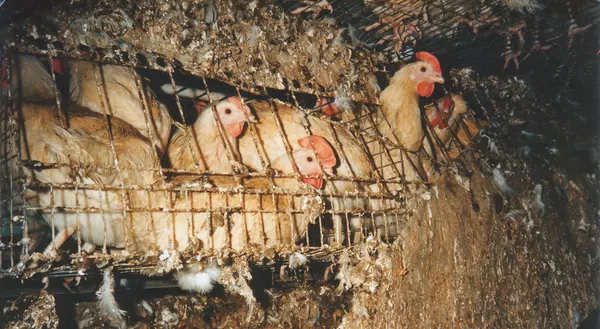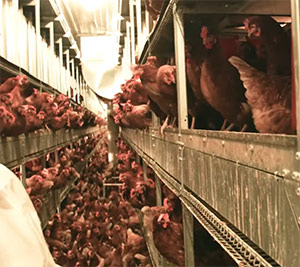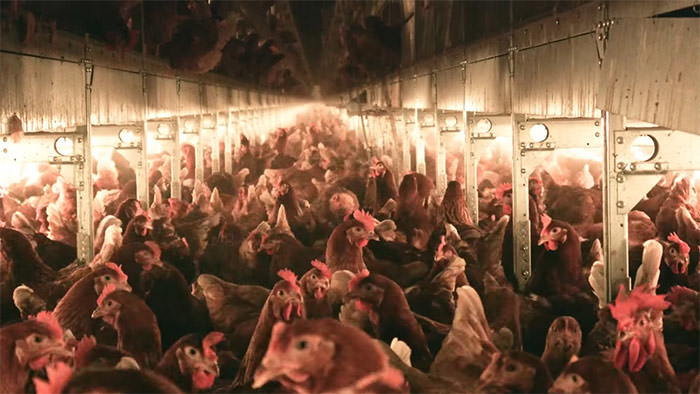The Egg Industry: Warehouses of Horrors
The egg industry tells us that chickens are insignificant and not worthy of concern. They are, however, living, feeling animals. And they have physical and behavioral needs.
Battery Cages

In the crowded “battery cages” of today’s egg factories, the hen’s most basic instincts are cruelly violated. Contrary to the barnyard roaming “happy hen” image promoted in egg advertisements, the life of a factory-farmed hen is one of intense suffering.
Roughly 60 percent of all laying hens spend their lives crammed six or more birds inside a cage measuring about the size of a microwave. Each bird is provided a maximum of 67 square inches of floor space, much smaller than a letter-sized sheet of paper.
Pressing up against the sides of the wire cage, hens lose their feathers. Competition for space within each cage is fierce. Birds low on the pecking order are helpless and cannot escape the pecking of the more aggressive, dominant cagemates. They incessantly strike out in frustration — pecking at the only thing available: each other — their skin becoming raw, often bloody.
Forced to stand on a sloping wire floor, their feet are injured. It is not uncommon for hens’ feet to become entangled in the wire flooring. Often such birds cannot reach their food and they slowly starve to death.
With barely enough room to stand, let alone walk or stretch their wings, hens cannot engage in normal behaviors such as nest building, dust bathing, perching, scratching the ground, and walking. Laying hens are confined in such cages shortly before they begin to lay and remain caged until they are shipped off to slaughter, usually at 70-72 weeks of age. Feeding, watering, and egg collection are completely automated.
As for hens who escape their cages, they frequently find themselves stuck in the building’s waste pit below the cages where they are often sucked into the mire and slowly suffocate.
“Cage-free” Operations

Other laying hens live in tightly packed confinement buildings, or so-called cage-free operations, where each bird is provided a mere one square foot of floor space to live out her life. One square foot is the standard promoted by the United Egg Producers, the egg industry’s trade association, which has openly acknowledged its goal of diluting the meaning of “cage-free.” Because these vast warehouses essentially become one giant, crowded, filthy cage, pecking, cannibalism, injury, and disease are rampant.
Chicks
To reduce cannibalism in such intensive confinement, chicks are “debeaked.” Debeaking is a painful procedure whereby the chick’s sensitive upper beak is sliced off with a hot blade. Many chicks die from shock during the process.
Male chicks are of no value to the egg industry. So, each year in the United States, hundreds of millions of male chicks are either tossed into machines that macerate – or grind – them alive or are thrown into plastic garbage bags to suffocate slowly under the weight of chicks dumped on top.

Slaughter
More chickens are slaughtered in the U.S. than all other food animals combined; yet, chickens are excluded from the Humane Slaughter Act, the federal law requiring that animals be rendered insensitive to pain prior to being killed.
Spent laying hens are not stunned before slaughter because it is thought that electrical stunning would damage the carcass due to the birds’ easily fractured bones. Lack of exercise and osteoporosis from heavy egg production cause the bones of laying hens to be very fragile and to break easily at the slaughterhouse.
Other Concerns
Whether battery or “cage-free” operations, veterinary care is non-existent. Individual hens are considered cheap and expendable. The high disease and mortality rates are considered economically acceptable. Thus, critically ill birds are simply thrown into large bins containing dead and dying birds. Over 98 percent of the egg market is now under the control of huge agribusiness corporations. Up to 350,000 birds can be confined in one factory farm warehouse and a single company may hold millions of hens. Such operations provide jobs for only a few dozen minimum wage attendants. If all that is not troubling enough, the industry relies upon antibiotics, pesticides, and other hazardous chemicals to keep these poor animals alive in such stressful, disease-promoting, and polluted egg factory environments.
You can help stop factory farm abuses and protect your own health by eliminating eggs from your diet. If you still choose to eat eggs, be sure to purchase only eggs laid by pasture-raised, undrugged hens.
For four decades, HFA has maintained an unparalleled track record of credibility and accuracy in addressing farm animal issues. HFA’s campaign against factory farming has highlighted the real-world effect of maintaining integrity and core values while pursuing animal protection.
It is these core principles that inform our campaigns and which will continue to result in real protections for farm animals.
Protect Farm Animals. Please Support HFA!
